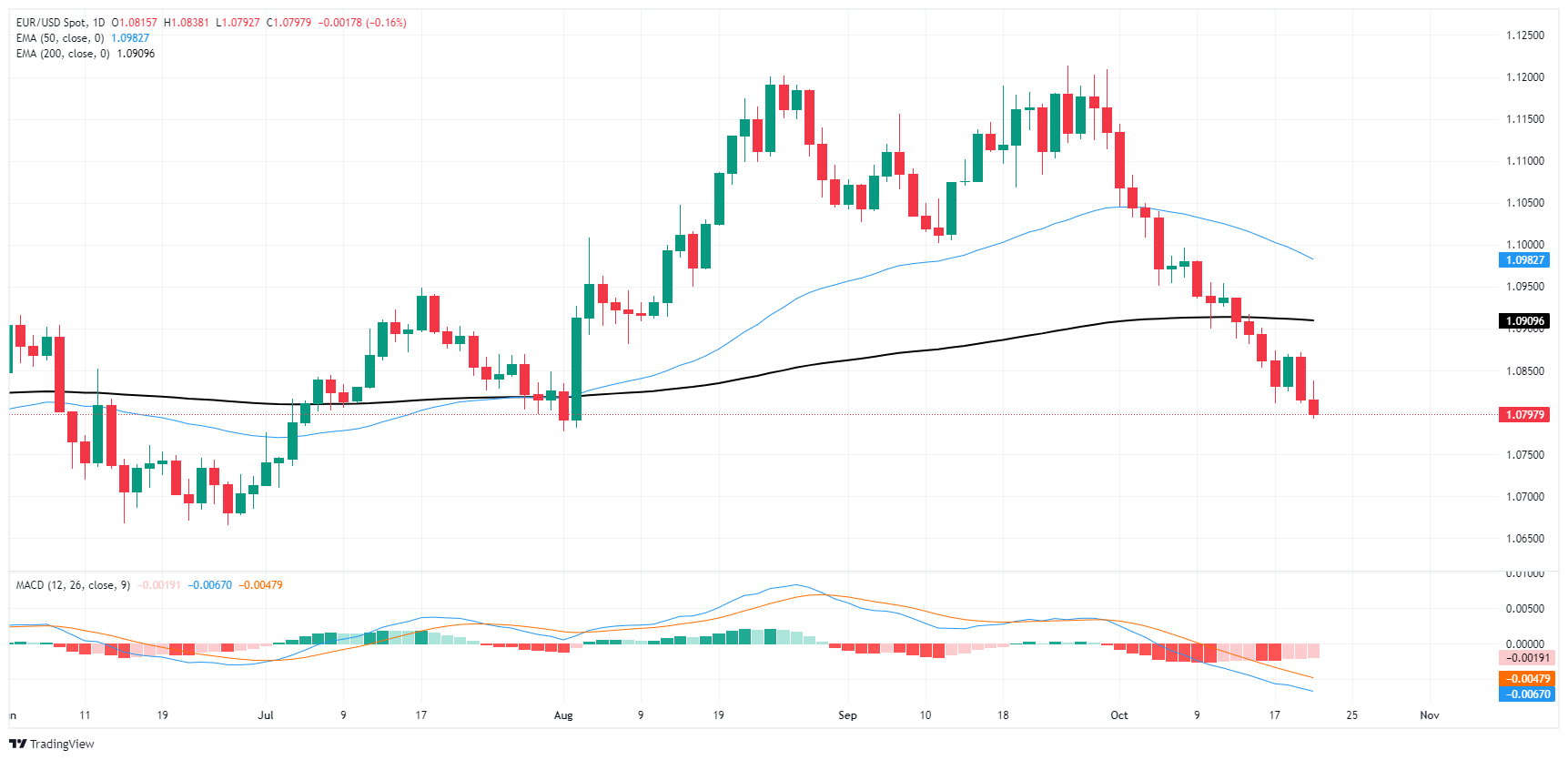EUR/USD tests further into the red, approaches 16-week low


- EUR/USD lost another sixth of a percent on Tuesday, dipping below 1.0800.
- ECB Lagarde’s middling comments did little to support Fiber bids.
- EU and US PMI set to clash on Thursday.
EUR/USD found further room on the low side on Tuesday, easing back another 0.16% and testing into a key technical barrier that could see fresh 16-week lows if the price floor opens up beneath the Euro.
European Central Bank (ECB) President Christine Lagarde made a handful of appearances on Tuesday, but talking points that ranged from pedestrian to unremarkable did little to support the Fiber. ECB head Lagarde noted that the ECB “is not unhappy with what it has seen”, adding in that the ECB “can’t jump to conclusion that inflation target is a done deal”, inspiring absolutely nobody in particular and delivering little of note in the way of forward guidance to currency markets that see the Euro on pace to backslide against the Greenback for a fourth consecutive week.
Global PMI figures are due for a rolling release on Thursday. Markets have high expectations for pan-EU PMI survey results, with median market forecasts calling for a slight uptick in October’s EU Services PMI to 51.6 from September’s 51.4.
EUR/USD price forecast
The EUR/USD pair continues to exhibit bearish momentum as it remains under pressure, trading near 1.0800. The pair has been consistently declining since mid-September, breaking below key support levels and now testing the 1.0800 mark. The 50-day exponential moving average (EMA) is positioned at 1.0983, while the 200-day EMA lies slightly higher at 1.0909. The fact that the price is trading well below both EMAs confirms that the short- to medium-term trend remains bearish. As long as the pair stays below these levels, the downside remains favored, with 1.0750 acting as the next major support area.
From a momentum perspective, the MACD indicator shows a strong bearish signal, with the MACD line extending further below the signal line. The histogram remains in negative territory, suggesting that the current downtrend may persist in the short term. A break below the 1.0800 psychological level could accelerate further declines toward the next support around 1.0750, while a recovery would need to break above the 1.0900 handle to signal a potential reversal.
EUR/USD daily chart
Euro FAQs
What is the Euro?
The Euro is the currency for the 19 European Union countries that belong to the Eurozone. It is the second most heavily traded currency in the world behind the US Dollar. In 2022, it accounted for 31% of all foreign exchange transactions, with an average daily turnover of over $2.2 trillion a day. EUR/USD is the most heavily traded currency pair in the world, accounting for an estimated 30% off all transactions, followed by EUR/JPY (4%), EUR/GBP (3%) and EUR/AUD (2%).
What is the ECB and how does it impact the Euro?
The European Central Bank (ECB) in Frankfurt, Germany, is the reserve bank for the Eurozone. The ECB sets interest rates and manages monetary policy. The ECB’s primary mandate is to maintain price stability, which means either controlling inflation or stimulating growth. Its primary tool is the raising or lowering of interest rates. Relatively high interest rates – or the expectation of higher rates – will usually benefit the Euro and vice versa. The ECB Governing Council makes monetary policy decisions at meetings held eight times a year. Decisions are made by heads of the Eurozone national banks and six permanent members, including the President of the ECB, Christine Lagarde.
How does inflation data impact the value of the Euro?
Eurozone inflation data, measured by the Harmonized Index of Consumer Prices (HICP), is an important econometric for the Euro. If inflation rises more than expected, especially if above the ECB’s 2% target, it obliges the ECB to raise interest rates to bring it back under control. Relatively high interest rates compared to its counterparts will usually benefit the Euro, as it makes the region more attractive as a place for global investors to park their money.
How does economic data influence the value of the Euro?
Data releases gauge the health of the economy and can impact on the Euro. Indicators such as GDP, Manufacturing and Services PMIs, employment, and consumer sentiment surveys can all influence the direction of the single currency. A strong economy is good for the Euro. Not only does it attract more foreign investment but it may encourage the ECB to put up interest rates, which will directly strengthen the Euro. Otherwise, if economic data is weak, the Euro is likely to fall. Economic data for the four largest economies in the euro area (Germany, France, Italy and Spain) are especially significant, as they account for 75% of the Eurozone’s economy.
How does the Trade Balance impact the Euro?
Another significant data release for the Euro is the Trade Balance. This indicator measures the difference between what a country earns from its exports and what it spends on imports over a given period. If a country produces highly sought after exports then its currency will gain in value purely from the extra demand created from foreign buyers seeking to purchase these goods. Therefore, a positive net Trade Balance strengthens a currency and vice versa for a negative balance.





.jpg)